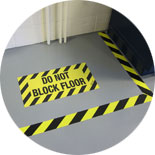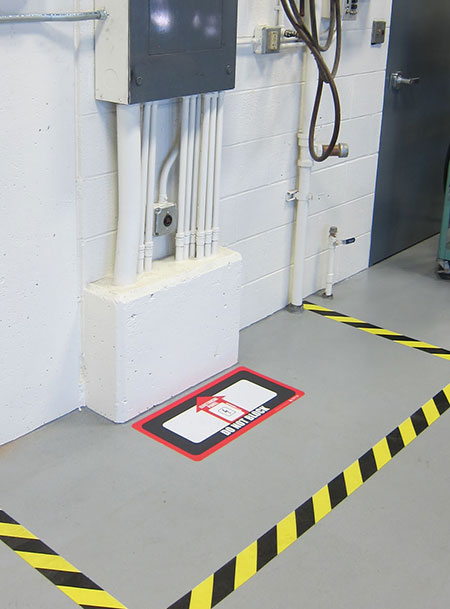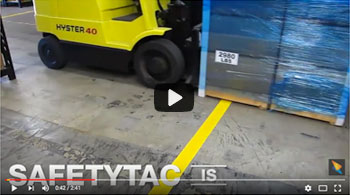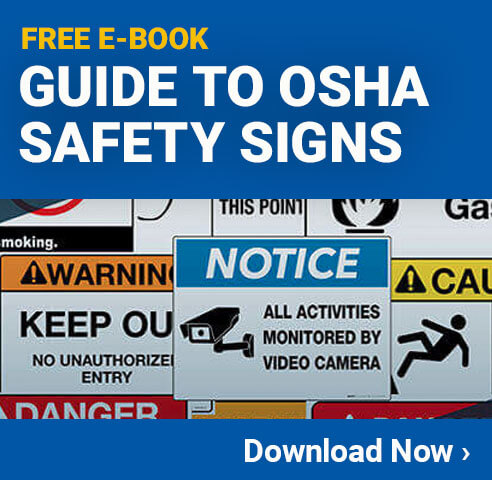
- OSHA Floor Marking
- Where to Use Floor Markings
- Keeping Pedestrians & Vehicles Separated
- Requirements for Marking Aisles
- OSHA Floor Markings for Electrical Compliance
- OSHA Floor Marking Color Guide
- Floor Marking Tape
- Floor Marking Shapes
- Types of Floor Markings
- Floor Marking Paint
- Using Floor Markings for Non-Safety Related Efforts
OSHA Floor Marking
Occupational Safety and Health Administration (OSHA) floor marking guidelines are covered in detail under standard number 1910.22. These guidelines help facilities determine how and where they need to use floor markings to improve safety. These standards cover things such as cleaning requirements for shop floors, standards for aisles and passageways, and much more.
Facility owners, managers, and safety professionals need to be sure they are always following the OSHA floor marking standards. This will help improve the overall safety of a facility and will also ensure there are no violations of the regulations, which could result in fines.
Where to Use Floor Markings
Floor markings can be used in areas throughout the facility. When making a floor marking plan, businesses should make sure there is a good balance between using enough floor markings to be effective and avoiding using so many markings that it just looks cluttered and confusing.

Aisles
Most facilities will benefit from using floor markings as an aisle marking tool. In fact, aisle markings are one of the only places where OSHA specifically identifies the need for floor markings. In addition to aisles, floor markings can be used to help keep vehicles traveling in approved ways.
Storage Areas
Using floor markings to improve the way things are organized is also an excellent idea. Sectioning off storage areas will help avoid having things put in the wrong places throughout the day. This is a good example of a Lean manufacturing strategy since it will keep the area cleaner and eliminate wasted time and energy.
Hazards
Identifying safety hazards using floor markings is another good option. While it is best to eliminate safety hazards when possible, alerting people to their existence is the next best way to handle it. Examples of these areas are placing floor markings around stairwells, openings in the floor, ledges, and anywhere else that could present a serious risk to those in the area if they walk into that space without proper care.Keeping Pedestrians & Vehicles Separated
One of the most important things that OSHA floor markings can be used for is to help keep pedestrians and vehicles away from each other. If a facility has forklifts, high-lows, or other indoor vehicles, using floor markings is a practical way to prevent accidents.
Creating floor markings to show pedestrians where they should be walking and vehicle operators where they should be driving will go a long way toward minimizing the overall risk of an accident. Vehicle-pedestrian accidents can be deadly, and using floor markings can be an effective way to keep everyone safe.
Requirements for Marking Aisles
OSHA standards offer specific guidelines regarding what needs to be done when marking aisles. For example, the aisle markings have to show the actual aisle space. If one part of shelving or a wall sticks out, the markings must reflect this so that those walking or driving through the area don't run into trouble.
The width of the markings should be sufficient to make it easy to see by everyone in the area. OSHA requires that the markings be a minimum of two inches wide, though six inches is preferred. This will help ensure that everyone in the area can see the markings. Using markings that are greater than six inches can also be troublesome. When they get too thick, people may mistake them for just the color of the floor when they see it in mirrors.
OSHA Floor Markings for Electrical Compliance

One of the most dangerous areas of any facility is near electrical equipment such as electrical panels. To help keep people safe, OSHA requires that facilities take steps to alert people to the potential danger and make sure they don't approach the area without proper safety gear.
Placing floor markings around all electrical equipment can help ensure everyone is aware of the hazard. It is also recommended that floor marking signs are put down so people can see the specific hazard that is present. The National Electric Code (NFPA 70 110.26) specifically says there has to be a clearance of three feet when there is electrical equipment that has 600 volts or less. Placing floor markings around that perimeter is an effective way to help stay in compliance with those requirements.
OSHA also has a variety of requirements regarding clearance distances in different types of electrical equipment. These are important for all types of electrical equipment, but especially high voltage areas, which can cause serious injury or even death in just a fraction of a second.
One last way to use floor markings around electrical equipment is to use them to prevent people from blocking the areas in front of these items. OSHA standards require areas around high voltage equipment to be kept clear so things don't fall into them and so people have immediate access when it is needed.
Putting down floor markings to set an area where things are not permitted to be stored is a good start. Floor marking signs can go further to state "œDO NOT BLOCK" to remind everyone that they are not permitted to put down any boxes or other items in the area.
OSHA Floor Marking Color Guide
One of the most important things to consider when putting floor marking tape or other markings down is the color you use. It is always important to follow the same standards throughout the facility to help avoid confusion. Belong are some common floor marking colors:
- Yellow Floor Markings - Yellow is recommended for marking off aisles and pathways within a facility. Identifying the edges of aisles with this tape can help vehicles avoid getting too close to shelving or other items. Yellow is also used in other areas where people need to use caution.
- White Floor Markings - White is a general-purpose color for floor markings and can be used for a wide range of different things. Most commonly it is used to identify storage locations. Placing a white outline around a storage container, for example, will help keep the facility better organized.
- Red Floor Markings - Red floor markings should be reserved for marking firefighting equipment such as fire extinguishers.
- Orange Floor Markings - Orange is normally used for organizing things within a facility that need inspection. Placing orange floor marking tape around an area where completed products go until they are inspected is a common use.
- Green Floor Markings - Green is normally used to mark off safety equipment. If there is a first aid kit on a wall, green floor marking tape may be used in that area to draw people's attention to it.
- Blue/Green/Black Floor Markings - These colors are often used to identify raw materials. They can also be used for work-in-progress items within the facility.
- Red & White Floor Marking - A red and white-stripped floor marking tape is used to let people know that the area must be kept clear for emergency access. This tape could be placed around fire hydrants, near emergency vehicle zones, and other similar areas.
- Bright Orange or Orange/Red Floor Markings - These colors are typically used to mark biological hazards in the area.
There are many other color options to choose from when buying floor marking tape. Choosing a color scheme for your facility and sticking to it is the best way to ensure everyone understands what the different color floor markings mean.
Floor Marking Tape
Of all the types of floor markings, floor tape is the most common. Floor marking tape can be applied quite long distances, such as along aisle ways. It can also be used to go around corners, mark off storage areas, and more.
High-quality floor markings can be used in almost any environment, both indoor and out. When installed properly, the tape can last for years without any trouble. See how floor marking tape should be installed in this quick video:
Floor Marking Shapes
In addition to tape, there are many floor marking shapes that can be used to improve organization and safety within a facility. The following are some common shapes and how they can be used:
- Stop Signs - Placing a stop sign on the floor is a simple way to ensure those driving indoor vehicles will know they must come to a complete stop.
- Arrows - Floor marking arrows help people get where they need to go. These can also be great for safety since they can be used to point people to an evacuation area.
- Exit Signs - While exit signs are typically hung up above doors, they can also be placed on the floor using floor marking letters. This is an effective way to direct people toward the nearest exit.
- Footsteps - Floor markings in the shape of footsteps are a good option for leading people in the direction you want them to go while in the facility.
- Warning Signs - Having floor marking letters spell out "warning" or else using shapes that signify a specific hazard are a great way to use floor markings to improve safety.
Types of Floor Markings
While floor markings are most commonly used to convey a visual message in the facility, they can offer other benefits too. Businesses can get floor marking tape that is made to be slip-resistant, even when wet. Placing this type of tape on the floor near entrances to the facility can help reduce the risk of slip and fall accidents quite significantly.
Not sure which floor tape you need?
The floor tape finder helps you choose the right floor tape for your job.
Another option is reflective floor marking tape, which will reflect light to make it quite visible. This is a great option for areas of the facility that aren't brightly lit. When a vehicle drives by with the lights on or a person walks by with a flashlight, the reflectors will help alert people to the presence of the markings so they can benefit from the markings.
Floor Marking Paint
While floor marking tape is typically the preferred option, some facilities prefer floor marking paint. When looking to meet OSHA floor marking standards, either paint or tape is acceptable. Floor marking paint comes in just about any color, and when applied to a clean surface it can last for a very long time.
Some limitations of paint are that it can be difficult to paint striped patterns when compared to using tape, which can be pre-printed. Floor marking paint can also chip and peel up more easily, especially in areas where there is a lot of heavy traffic that can scrape the paint up over time.
Choosing between paint and tape is going to be a decision each individual facility will need to make based on their budget and what type of marking they like to work with.
Using Floor Markings for Non-Safety Related Efforts

Floor markings can be used for a wide range of different things in a facility. When using them for things that are unrelated to OSHA standards such as waste prevention or improved organization, it is important to ensure the markings don't cause confusion with the safety markings.
Setting aside one color marking specifically for waste prevention efforts can prevent people mistaking that marking for something else. Whenever using visual communication strategies like floor markings, clarity is absolutely essential.
Taking the time to ensure employees are properly trained on what the meaning of each type of floor marking is will help improve the effectiveness of any strategy. This can be done by providing training classes, training handouts, putting up floor marking posters, and more.
OSHA floor marking standards are put in place to help improve the safety of a facility. If an overall floor marking plan does not sufficiently improve overall safety, it is not an effective use of floor markings.
Sources
- https://osha.gov/pls/oshaweb/owadisp.show_document?p_table=STANDARDS&p_id=9793
- https://en.wikipedia.org/wiki/Pedestrian
Similar Articles
- Floor Marking Ideas for Warehouses
- Floor Marking for Forklift Traffic
- Floor Marking for Electrical Panel Compliance
- Floor marking comprehensive research, education and training
- Floor Marking for Factories
- Types of Floor Marking
- Floor Marking for Fire Extinguishers
- Floor Marking for Facility Safety
- Industrial Floor Marking Guidelines



